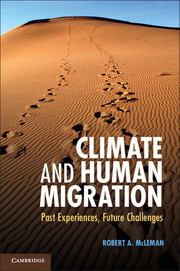Book contents
- Frontmatter
- Dedication
- Contents
- List of Figures
- List of Tables
- Preface
- Acknowledgments
- 1 An Introduction to the Study of Climate and Migration
- 2 Why People Migrate
- 3 Migration in the Context of Vulnerability and Adaptation to Climatic Variability and Change
- 4 Extreme Weather Events and Migration
- 5 River Valley Flooding and Migration
- 6 Drought and Its Influence on Migration
- 7 Mean Sea Level Rise and Its Implications for Migration and Migration Policy
- 8 Emergent Issues in Climate and Migration Research
- Annex Estimates of Global Population Exposed to Tropical Cyclones
- References
- Index
7 - Mean Sea Level Rise and Its Implications for Migration and Migration Policy
Published online by Cambridge University Press: 05 December 2013
- Frontmatter
- Dedication
- Contents
- List of Figures
- List of Tables
- Preface
- Acknowledgments
- 1 An Introduction to the Study of Climate and Migration
- 2 Why People Migrate
- 3 Migration in the Context of Vulnerability and Adaptation to Climatic Variability and Change
- 4 Extreme Weather Events and Migration
- 5 River Valley Flooding and Migration
- 6 Drought and Its Influence on Migration
- 7 Mean Sea Level Rise and Its Implications for Migration and Migration Policy
- 8 Emergent Issues in Climate and Migration Research
- Annex Estimates of Global Population Exposed to Tropical Cyclones
- References
- Index
Summary
Introduction
Sea levels are presently rising by approximately three millimeters per year as a result of anthropogenic climate change, with the thermal expansion of ocean water and melting of Greenland and Antarctic ice being key contributors. A few millimeters may not sound like much, but over the course of this century the cumulative effects will present significant challenges for populations living in low-lying coastal plains, deltas, and on small island states. In recent years the popular media has identified communities in Alaska, Papua New Guinea, and Vanuatu as the first climate change refugees, by virtue of having to relocate because of coastal erosion and encroachment of the sea. In the scholarly community there has been a recent surge in the number of publications on the question of what to do – legally and practically – about people displaced by rising sea levels. Such questions are difficult to answer for a number of reasons, not the least being that we have few direct precedents to draw on. A particularly difficult problem will be what to do if entire sovereign states become uninhabitable as a result of mean sea level rise.
In suggesting answers to these and other related questions, this chapter:
Reviews the physical processes that affect the relative locations of coastal settlements and the sea, and identifies current and projected rates of change
Describes the impacts of sea level change on coastal settlements
Provides rough estimates of the number of people exposed
Identifies options in adaptation, including migration
Explains the challenges faced in dealing with people who may become internally displaced within their own countries by rising sea levels
Considers the situation of citizens of states that may cease to be habitable
Analyzes international legal arrangements that may be somewhat applicable to the protection of displacees
Suggests pathways for action by a concerned international community
- Type
- Chapter
- Information
- Climate and Human MigrationPast Experiences, Future Challenges, pp. 180 - 209Publisher: Cambridge University PressPrint publication year: 2013



